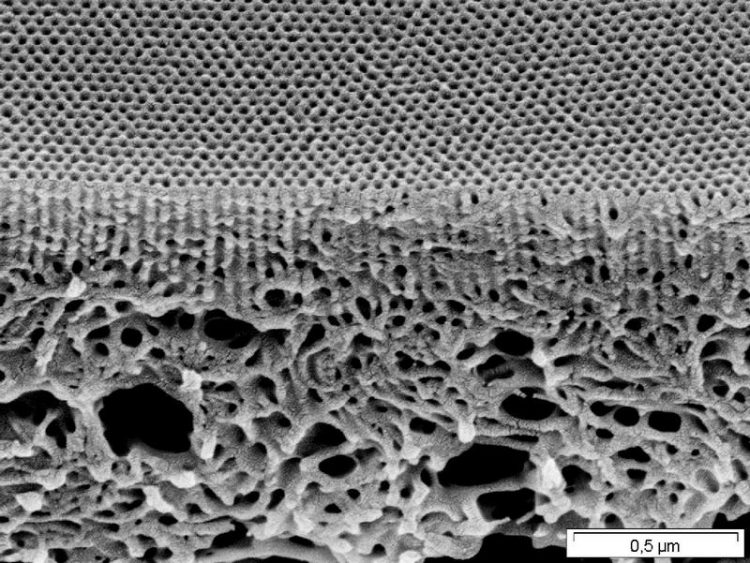Blending is the Trick: Tailored Pores in Block Copolymer Membranes

Tailored Pore Sizes in Integral Asymmetric Membranes Formed by Blends of Block Copolymers [HZG, Abetz]
Whether it’s water treatment or virus and protein separation, porous membranes are utilised in many different separation functions. What is particularly fascinating and highly promising is isoporous membrane production from block copolymers.
Under suitable conditions, block copolymers can form highly ordered structures, ideally uniform pores, through self-assembly (see “Block Copolymer Information” below).
In order to develop effective membranes for special separation functions, the correct pore size is crucial. This objective presents the greatest challenge: how must the block copolymer be composed in order to obtain the desired pore size?
To date, for every newly developed isoporous membrane a special block copolymer was synthesized, which then resulted in the necessary pore size. In cooperation with the director of Geesthacht’s Institute of Polymer Research, Prof. Volker Abetz, Dr. Maryam Radjabian has now developed a time-saving and surprisingly simple method: by blending of two block copolymers, the pore size can be adjusted via the blending ratio.
The two block copolymers consist of the same monomers but differ in the number of repetition units in the blocks. A different pore size then arises in the particular membrane cast from each block copolymer. Dr. Radjabian’s concept of obtaining an average pore size by blending two block copolymers has been corroborated in experiments.
This opens up entirely new possibilities for designing new membranes. The scientist at the Institute of Polymer Research explains, “There is a substantial advantage in not having to synthesize a precisely suitable block copolymer to obtain the desired pore size, but in simply mixing two approximately suitable copolymers together.”
Block Copolymer Information:
Block copolymers consist of at least two types of monomers, each covalently linked together as polymer blocks (a group of the same monomers) in the form of a macromolecule. Because the blocks of macromolecules are selected so that they are not mixable (“immiscible”), self-assembly of the macromolecules takes place through rejection reactions (microphase separation).
Isoporous Membranes can be produced from a block copolymer solution under defined conditions by utilising the phase inversion principle. The foundations for this research were developed within the HZG-coordinated European Union project SELFMEM (2009-2012).
DOI: 10.1002/adma.201404309: Tailored Pore Sizes in Integral Asymmetric Membranes Formed by Blends of Block Copolymers, Maryam Radjabian, Volker Abetz
Advanced Materials 2015, 27, 352-355, (online 20 Nov.V 2014)
http://www.hzg.de/public_relations_media/news/058880/index.php.en – website HZG
http://dx.doi.org/10.1002/adma.201404309 — Publication
Media Contact
All latest news from the category: Materials Sciences
Materials management deals with the research, development, manufacturing and processing of raw and industrial materials. Key aspects here are biological and medical issues, which play an increasingly important role in this field.
innovations-report offers in-depth articles related to the development and application of materials and the structure and properties of new materials.
Newest articles

Superradiant atoms could push the boundaries of how precisely time can be measured
Superradiant atoms can help us measure time more precisely than ever. In a new study, researchers from the University of Copenhagen present a new method for measuring the time interval,…

Ion thermoelectric conversion devices for near room temperature
The electrode sheet of the thermoelectric device consists of ionic hydrogel, which is sandwiched between the electrodes to form, and the Prussian blue on the electrode undergoes a redox reaction…

Zap Energy achieves 37-million-degree temperatures in a compact device
New publication reports record electron temperatures for a small-scale, sheared-flow-stabilized Z-pinch fusion device. In the nine decades since humans first produced fusion reactions, only a few fusion technologies have demonstrated…





















